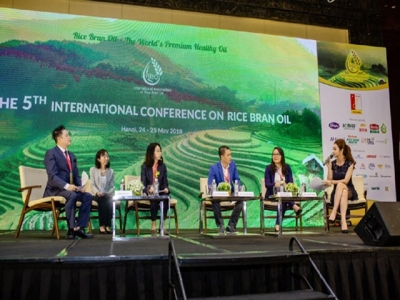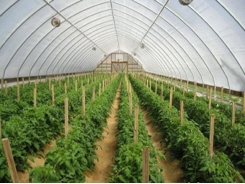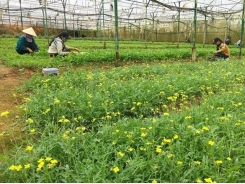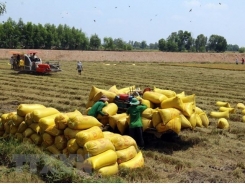Vietnam - potential market for rice bran oil

Vietnam has recently joined the group of rice bran oil-producing countries, with a modest output, but as one of the largest rice exporters in the world, the country has great potential for developing this industry.
The roundtable discussion at the conference, hosted by Miss Jennifer Pham.
More than 200 participants including experts, researchers, and representatives of rice bran oil companies from 20 countries of 5 continents ... discussed how to promote the global production and trade of rice bran oil at the International Conference on Rice Bran Oil 2018 (ICRBO 2018) in Hanoi, Vietnam this May.
Potential has not been adequately exploited
Deputy Minister of Industry and Trade Cao Quoc Hung said: "Producing rice bran oil to meet the market demand is a major concern of the leading rice bran oil companies in the world. Rice bran oil has been recognized by the World Health Organization (WHO) as one of the healthiest cooking oils. Vietnam has great potential for rice bran oil production, but its output is still limited. However, it is proud to say that Vietnam also contributes to the world rice bran oil market with high quality products."
Dr. B.V Mehta, President of the Solvent Extractors’ Association of India, said: "Although Vietnam has recently joined the group of rice bran oil-producing countries, with a modest output, as one of the largest rice exporters in the world, the country has great potential for developing this industry.”
He also pointed out the remarkable benefits of rice bran oil for health, and the reason why India is currently one of the world's largest rice bran oil producers.
Nowadays, rice bran oil is so popular in India. More than 300 KFC restaurants in the country have abandoned palm oil to use rice bran oil. According to Dr. B.V Mehta, hundreds of food and food technology corporations in the world have invested in research and production of rice bran oil, which shows that the demand for rice bran oil in the world is increasing strongly.
China is leading the world in the consumption of cooking oil. However, its output of cooking oil only meets 32.3% of the demand of the local market. The country with a population of over 1,4 billion people has to import nearly 70% of the remaining volume of cooking oil, including rice bran oil.
In Japan, the people have used rice bran oil in their daily meals for decades. Consumption of rice bran oil in this country in 2017 reached 90,163 tons, up 10,000 tons compared to 2016. Japan used about 53% of its total volume of rice bran to extract oil in 2017, but the country's rice bran oil production capacity rose only by 3.7 percent in the last decade, from 63,378 tons in 2006 to 65,731 tons in 2017. Japan previously exported rice bran oil, but now it has to import this product from other developing countries to meet the local demand
Challenges for Vietnam
Mr. Peh Ping Teik - President of the International Association of Rice Bran Oil 2018 - and many experts said that rice is the staple food of billions of people around the world, especially in Asia. However, few know that rice bran can be used to extract cooking oil. On the other hand, the biggest difficulty for countries participating in the world rice bran oil production chain is the technology and quality of raw materials.
Extracting oil from rice bran requires a great investment in technology, which is a big difficulty for many countries. For Vietnam, it has imported modern rice bran oil production technology and has been named on the international map of rice bran oil producing countries. However, it still lacks good quality rice that meets the criteria for rice bran oil production. Thus, Vietnam has just used 10% of its rice output for this potential industry.
Regarding the issue of marketing rice bran oil on the global market, Mr. Tran Anh Dung – Head of Brand of Cai Lan Oils & Fats Industries Co., Ltd - said that due to the production process of rice bran oil is longer and more complicated, the amount of oil extracted from 1kg of rice is lower than that from 1kg of soybean or sunflower seeds. It takes from 150kg to 200kg of rice paddy to produce 1 liter of pure rice bran oil, so the output of rice bran oil is not high and the production cost is higher than other common types of cooking oil for about 10%. Therefore, up to 80% of the company’s rice bran oil output is for export and only 20% is for the domestic market
In addition, consumers prefer cooking oils with light yellow color, which comes from misunderstandings about the natural dark color of rice bran oil.
Mr. Dung said that the technology to extract rice bran oil is more complex than that for the olive oil, as the oil from rice bran must be preliminary treated within 6 hours to maintain the highest concentration of Gamma-Oryzanol.
In order to make use of the available raw materials, Vietnam has imported the world's most advanced rice bran oil refining production lines of Desmet Ballestra (Belgium). As a result, the quality of Vietnam's Simply pure rice bran oil is similar to that of rice bran oil produced in developed countries, meeting strict standards for export to the fastidious markets like New Zealand and Australia.
In the near future, the company will step up marketing activities on a large scale, so that many people will know about the benefits of rice bran oil and have the opportunity to try Simply rice bran oil. The company is also expanding its distribution channel of this product so that consumers can easily find it in the market and at supermarkets.
Using rice bran oil is becoming a popular trend around the world. This is the only vegetable oil that contains Gamma-Oryzanol, which is 4 times stronger than vitamin E as an antioxidant and helps to reduce bad cholesterol absorption, prevent cardiovascular disease, and slow down the aging process
Related news
Tools

Phối trộn thức ăn chăn nuôi

Pha dung dịch thủy canh

Định mức cho tôm ăn

Phối trộn phân bón NPK

Xác định tỷ lệ tôm sống

Chuyển đổi đơn vị phân bón

Xác định công suất sục khí

Chuyển đổi đơn vị tôm

Tính diện tích nhà kính

Tính thể tích ao



 Internet of Things helps farmers boost, improve production
Internet of Things helps farmers boost, improve production  Mekong Delta province to shift rice fields to…
Mekong Delta province to shift rice fields to…